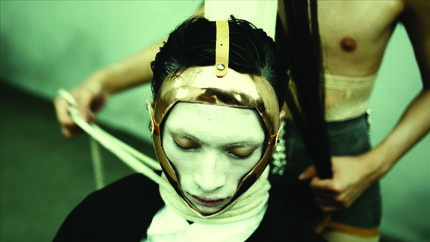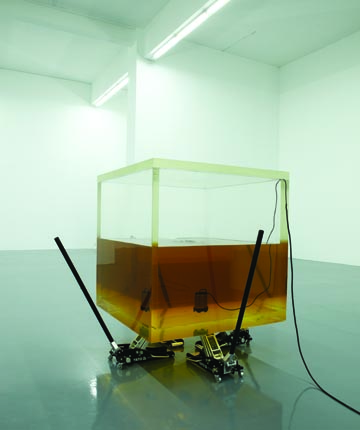RAN HUANG
| June 28, 2012 | Post In LEAP 15

The greatness of Edouard Manet’s The Execution of Maximilian, according to Georges Bataille, lies exactly in its relationship to the original— Francisco Goya’s El Tres de Mayo 1808— or its inheritance of resistance: the regard for and expression of indifference. “There is no essential difference between him painting the scene of an execution or painting a fish or a flower,” Bataille said. By replacing the expression of passionate or romantic impulse with indifference, Manet was not attempting to imitate Goya by placing the bloodiness of the massacre above its historical scenario in pursuit of an objective, conclusive depiction of the event; rather, at the same time as feigning sincerity to meet the trite demands of the art salons, he assumed a majestic, classical appearance to conceal his actual apathy towards its significance. Historical rationale is here trumped by a kind of everyday logic, for at the precise moment of death, the terror of it is eliminated. This also applies to a particular form of interaction between artist and system, a deliberate pandering to the violation of laws, and can be regarded as a kind of “transgression.”
When Ran Huang mentioned that he has been influenced by Bataille, the first thing that came to my mind was not the more obvious “thematic” convergences and combinations of his work, but rather, the idea that the critique Bataille so emphasized must have entered the realm of sociology (as Bataille put it: “no sphere of knowledge can be more beneficial to art than sociological analysis”). Transgression is also a kind of exchange, furthermore it is an intense form of exchange between the internal and external agents of a system— the surface and its inner layer— and this intensity creates a disenchanting tension or deflation between individual and community. Ran Huang has arrived at his own distinct understanding of the many kinds of inevitable sociological diseases which afflict the relationship between artist and system, and in his work attempts to reveal and overcome them. This creative tendency naturally has something to do with the specialist training he received at Goldsmiths College, London. In one sense, the high-intensity training granted him the opportunity to shift the standard of his practice to that of an individual author; in another, limitless contact with a system made him especially sensitive to modes of exchange between the self and the community. And although his current practice differs greatly from his earlier creative tendencies, this theme has seemingly remained a latent focal point of Huang’s work.
In discussion with LEAP, Ran Huang repeatedly expressed his mistrust and suspicion of existing art contexts, and attempted to put forward his own individual understanding of certain “keywords,” though at the same time acknowledged his own membership of and flourishing within the art system. This persistently iconoclastic stance lends something special to his work, and betrays a self-awareness and professionalism well beyond his years. Although frequently invoking the longing atmospheres of Goya, the crux of Huang’s work lies in a study of the “indifference” of Manet— something which could of course also be called a kind of “dynamic indifference.” This dynamism stems from the turning of this indifference into a metaphor, into some kind of concealed, silent— this is how Bataille described Manet’s paintings— destructive force. For example, in his 2009 piece The Next Round is True Life, Huang turned his eye towards the fashionable, clamorous concept of “revolution,” though all that can be seen is the repeated chewing of a single piece of gum, passed back and forth between three people for over 20 minutes. The “silent” quality of his work is both firm and precise, his subversive and acute eye for meaning does not depend on states of “excess” or “surplus,” but enacts a plain and direct attack on our everyday experience, probing into the many possible conspiracies and ambiguities which lie behind it— we must break through various buffers (such as the need to put out of our mind the “unclean saliva” of others in the video) before being able to arrive at the actual world this author is attempting to convey; like the “better tomorrow” projected by revolutionary idealism, or the marginal effect of commodity, it will constantly be diluted by various political strategies.
What must be pointed out is that this “silence” is actually the major booby-trap of Ran Huang’s work. It is in fact an artistic strategy to resist shallowness and noise, whilst rising up from within it is a desire to expose and reinterpret the world. In Turn Over (2009), a camera persistently focuses on three sets of identical twins as they play basketball, their various movements forming a strong impression of the “communication of non-communication.” Yet both these film works (The Next Round is True Life and Turn Over) still stop at the pure operation of abstract concepts. Starting with these videos and proceeding to a comprehensive study of his present work, we can perhaps conclude that his work roughly underwent a transformation from “fable” to “image.” During an earlier stage, the more fable-like video works presented the audience with the great challenge and allure of decipherment, but a constantly intensifying interrogation of the capabilities and responsibilities of art has led him from this more linguistic practice towards a new, experientially-based pursuit. Or, it could be said, from the primary linguistic system of video to the unstable, more open and “impure” visual system of cinema. In his own words, the reason for his change of direction is due to the powerful reconstructive abilities of cinema as well, as its potential to rise to the expectations of tremendous cultural energies. So, from Fake Action Truth onwards, Huang in one sense continued to implement his preferred focus on the destruction of stability, but in another, this destruction gradually began to draw on an increased attention towards disparities between the “facts” and “meanings” of images. Film, or “filmness,” has now become the foundation and essential stance of his practice, allowing the narrative unfolding and visual spectacle of his themes to combine.

In the piece Blithe Tragedy, Ran Huang began to conduct large-scale experiments with cinematic figures. The characteristics of the language of video art intervene in these figures, which almost enter a kind of semiotic danger zone, a non-autonomous process of exchange: the strength of cinema relies on the absolute autonomy of figures, on activating the primary visual power of images at a “superficial” level. This cryptic work, full of lust and death, according to Huang, is an attempt to celebrate the return of “evil” and death, which, if read according to Foucault’s concept of the “dispositif,” regardless of either the numerous cinematized elements (lighting, setting, and character figures) or its art “aura”— especially in view of both the artist’s emphasis of image and his response to Goya— its renewed deployment and re-ordering of desire attempts to reflect Bataille’s notion of “non-productive expenditure, and waste over production” as sacred. But in the end, if all we can find in this piece are its strange figures, then from which point can we begin to discuss “transgression” and destruction? At this point we would do well to turn to Jean-François Lyotard’s concept of the “figural.” According to Lyotard, there exists between figure and desire a kind of “radical connivance,” and in “transgression” this implicit willingness provokes (for example, in the ways in which dreams manifest) the failure of pre-assigned semantic and textual notions of figural, thereby welcoming the downfall of the figural— under these conditions, the figural is often expressed by a rebellion against and subsequent transformation of figures.
The issue of figures is forever bound to some kind of visible system (régime), a certain dimension of knowledge (savoir), the possibility of transformation into a linguistic description; but the figural is distinct from the figure, it is a formless impression, the realization of a disfigurement, unable to be articulated or uttered and forever existing in flux. It thereby aptly brings Bataille’s idea of the “unknowing” (non-savoir) to the spectator, exciting the realm of “inner experience,” and re-comprehending the world through the desire for novel interpretations. The elongated nose, androgynous bodies, medieval instruments of torture, piles of corpses, botanical drawings on the walls, even the condensed light in the forest— these indescribable and heterogeneous elements together become myths, and ferment in the slow push and pull of the camera. Concepts of death, erotica, violence and romance are gradually engulfed and disappear, finally forming into a new mythology of the figural.
According to Lyotard: “art needs figures, the figural brings beauty to them.” That which Blithe Tragedy tries to bring about is actually an accumulation, an amalgam of different kinds of unstable, indecipherable elements, which possess the possibility to form new aesthetics; the spectator’s experience of “beauty” doesn’t come from the uniqueness of the figures, but from the un-externalizable meaning and sense of beauty which is released from the figural after its subversion. And, as for Ran Huang’s repeated expression of “indifference,” disparate materials are appropriately assembled; complex concepts and implicit historical clues, through the confluence of the figural and structure, are assembled into perceptible textures, whilst potentially extravagant symbols, fantasies, and merriments are carefully discarded, various powers are neutralized and distributed evenly across the flesh of the work. In a recent installation, titled The Weakness of Will, and the Fear of Society, this nervous charm, born of careful restrain, can also be perceived in the opposing and unstable coexistence of oil and water.

But in Ran Huang’s recent video Disruptive Desires, Tranquility and the Loss of Lucidity, the attachment to the figural and structure initiated in the last work doesn’t seem to have developed very far. Although on this occasion he attempts to resolve more pressing issues, he appears to have been hemmed in by the formulas of cinema itself: his increased proficiency at the manipulation of elements, and refinement of his craft, causes the power of the images themselves to occasionally rupture and recombine, then get stitched back together into something that complies with the often domineering aesthetic atmosphere of “cinema.” Talking to LEAP, Huang repeatedly emphasized his production of “unsafe” images, yet watching this film, the overriding feeling is that the excessively tight and precise sheen of the images brings about the kind of “virtuosity” of which Paolo Virno speaks; or, it could also be said that the ultimate pursuit of figures in the end doesn’t actually bring the transgressive to the figural, but instead ultimately brings about the images’ neglect and sanitization. Naturally, as a young artist, it is remarkable that Huang has already begun to establish such stable, familiarizing traits. The tenacity of his professionalism and clear ability to make decisions and revisions can only fill one with hope for his future creations. But, at the same time, the hope must also be that fate and the vicissitudes of life can take him to places he would never have imagined, and ensure the continuing realization of his own potential.

